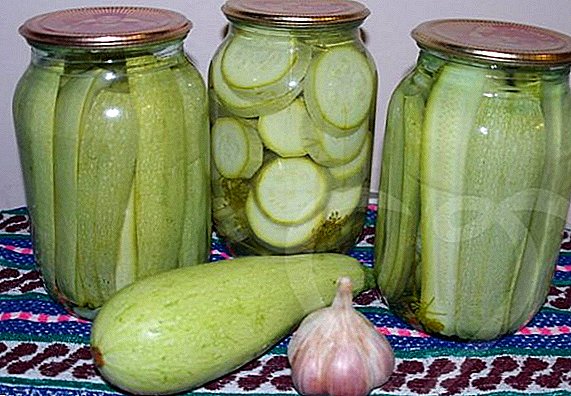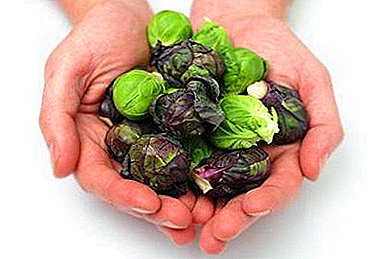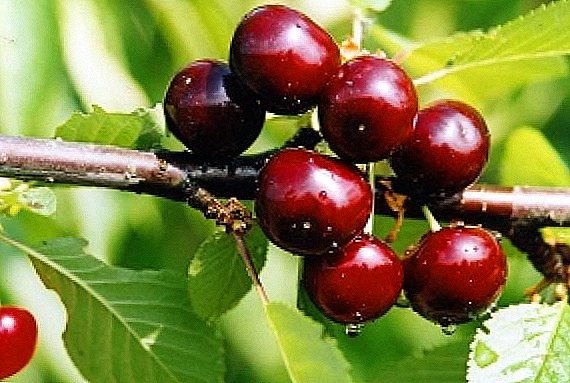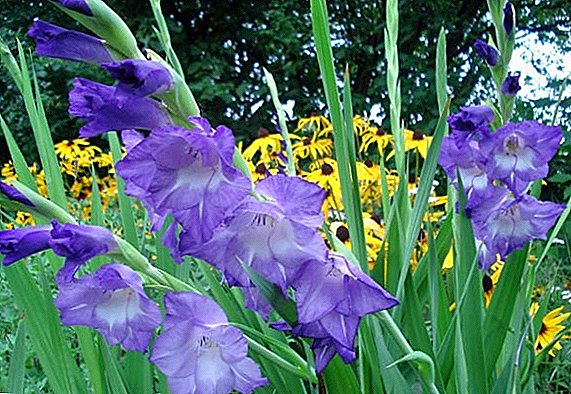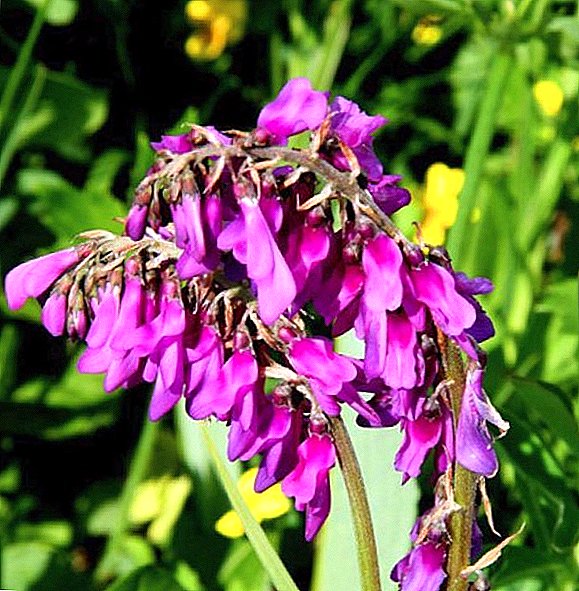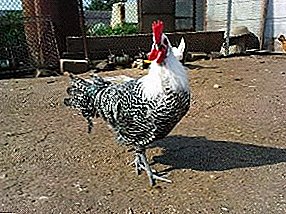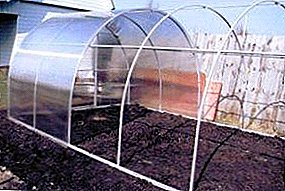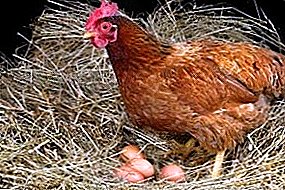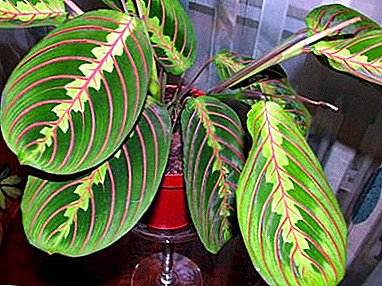
Maranta tricolor or arrowroot tricolor is a grassy undersized plant from the family of the same name.
The natural habitat of its habitats are rainforests of Central and South America.
The amazing feature of leaf blades of arrowroot to form and rise with a lack of light formed the basis of its second name - "prayer plant".
Below you can see a photo of arrowroot of a three-colored or prayer plant:





Home care
Caring for arrowroot at home is no different from most other plants.
When buying, you should carefully inspect the plant, abandoning the purchase of strongly overgrown, old or, conversely, young, not yet gained strength, as well as weakened seedlings.
Important!The best time to start flower cultivation is April - May.
After delivering arrowroot home, it should be protected from the damaging effects of dry room air. To this end, the plant sprayed separated by warm water from a spray bottle several times a day until it adapts to new conditions for it.
By the way, such hydroprocedures are necessary for the flower throughout the entire period of its growing season: in the winter at least one, and in the summer - twice a day.
Pruning
As the arrowroot develops, some shoots are strongly drawn out, so they require removal. At the same time, the operation of pruning lateral overgrown plant parts not only improves its aesthetic perception, but also has a positive effect on its further formation, since provokes growth new young shoots from the central part of the flower.
Watering and spraying
 Maranta requires abundant and regular watering, not allowing excessive overdrying of the soil. However, the excessive moisture of the substrate can be detrimental to the plant, since it leads to the rotting of the root collar.
Maranta requires abundant and regular watering, not allowing excessive overdrying of the soil. However, the excessive moisture of the substrate can be detrimental to the plant, since it leads to the rotting of the root collar.
Usually in the summer watering is carried out in one day, and in the winter - 1-2 times a week. For this procedure, only rain, snow, tap water or separated water is used.
A reliable indicator of the need for regular watering is the drying of the surface layer of the earth to a depth2 cm.
Spraying also has a beneficial effect on the plant, especially in summer.
Important! In some cases, this procedure can lead to white streaks on the leaves. As an alternative to a wet shower, near the arrowroot, you can install plastic pallets or other containers with gravel or expanded clay, filled with water.
Landing
When planting a plant is best suited shallow but wide ceramic or plastic pot. This is explained by the fact that the arrowroot roots do not penetrate deep into the soil, but form additional underground tubers, which require sufficient free space for their development.
To grow healthy and beautiful indoor plants, it is worth preparing a balanced breathable substrate with a weakly acidic reaction environment.
As the latter, either ready-made shop formulas or self-made mixtures are used. The following option has proven itself well:
- 2 parts peat;
- 1 part of coarse river sand;
- 2 pieces of leafy humus.
 Deserves special mention and such a universal mixture:
Deserves special mention and such a universal mixture:
- 2 parts peat;
- 4 pieces of leafy humus;
- 1 part rotted manure;
- 1 part of river sand.
To give the substrate greater looseness, you can add pine bark, sphagnum, crushed charcoal or coniferous earth. Additionally, they arrange drainage by pouring claydite, broken brick or small crushed stone with a layer up to 5 cm to the bottom of the flowerpot.
The video shows the highlights of flower care:
Transfer
The best time for such manipulation is considered Spring. Before transplanting the arrowroot, wilted and dried, as well as old leaves are removed, so that they do not interfere with the normal formation of new shoots.
Growing from seed
Along with vegetative propagation of a plant, a new flower can be obtained with the help of seeds. To do this, the latter are sown on a well-drained substrate with temperature 13 - 18 ̊ С which should be maintained throughout the growing season.
Breeding
There are several ways to grow a plant.
- Dividing bush. In this case, when transplanting arrowroot, the maternal rhizome is divided into several daughter tubers with well-developed roots and leaf plates. Young individuals are planted in separate containers with loose, light ground and covered with plastic film or plastic cap for better survival. After that, the pots are placed in a warm place for the final rooting of the plants.
- Cuttings. From apical shoots take a section of the stem length of 8 - 10 cm with two internodes and several healthy leaves, and then placed in a container with distilled water. To speed up root formation, the cuttings are treated with a growth promoter. The germination process usually takes 1 - 1.5 months. After this, the cuttings are transplanted into an air-permeable peat-sand substrate and well watered. For the rapid rooting of seedlings arrange small greenhouses.
Temperature
The ideal temperature for the cultivation of arrowroot is 20 - 26 C in the summer and 16 - 18 C in the winter.

Lighting
Maranta does not tolerate direct sunlight, however, and strong shading adversely affects its appearance: the lamina is reduced in size, losing its rich greenish color.
The plants feel best either when bright ambient light (penumbra), or under artificial light fluorescent lamps for 16 hours a day.
Benefit and harm
The decorative form of this plant is valued by flower growers for a beautiful rosette of oval leaves, in the color of which different shades of green predominate, complemented by an accent in the form of bright veins, stripes and spots.
A close relative of this flower - maranta cane - is widely used in cooking. Here underground tubers rich in starch (up to 25%) are used. They get the flour, which goes to the preparation of nutritious puddings, sauces, soups, stews and bakery products.
Different types of arrowroot have healing properties. It is believed that a pot with a live plant, installed next to the bed, can heal insomnia. A number of amateur flower growers believe that it harmonizes the inner living space, helps to cope with bad mood and attacks of aggression, smoothes out quarrels.
Human Exposure Hazardous Effects not having, because it does not emit poisonous milky juice and does not have sharp edges, leading to cuts.
Important!In any case, caution must be followed by people suffering from severe allergic diseases and bronchial asthma.
Diseases and pests
Spider mite

This is one of the most dangerous plant pests. It settles on the lower side of the leaf blade, causing the appearance of white spots and a thin cobweb. Over time, the leaves lose their usual color and fall off.
For the prevention of this phenomenon, it is necessary to avoid excessive dryness of the air in the room, producing periodic spraying flower water. In the case of an already developing disease, special insecticidal preparations are used, in particular, "Fitoverm", "Aktellik", "Funanon", etc., as well as pollination by sulfur preparations in the open air outside the living room.
Shchitovka

A sign of the damage by this pest is the appearance of brown protrusions on the leaves and stems. The lamina dries out, twists, loses its characteristic color and falls off (for details on what to do if leaves of arrowroot turn yellow and dry, as well as what diseases and pests can destroy the flower and how to treat the plant, read here).
A radical means of combating this disease is either washing the affected areas of the plant with a 5% soap emulsion (20 grams of laundry soap per 10 liters of water) or spraying the Actellica solution prepared at the rate of 1 to 2 ml of the product per 1 liter of water.
Mealybug

It strikes primarily leaf stalks. For its destruction use the same drugs as in the case with the shield. If necessary, the treatment is carried out repeatedly until a stable result is achieved.
Maranta tricolor - not a simple plant, because for its normal growth and development requires strict adherence to agricultural cultivation. However, all these efforts will pay off handsomely, because “praying grass” is one of the most beautiful tropical plants that will delight the eye with luxurious velvety leaves with a unique pattern over the years.



